Install the app
How to install the app on iOS
Follow along with the video below to see how to install our site as a web app on your home screen.
Note: This feature may not be available in some browsers.
You are using an out of date browser. It may not display this or other websites correctly.
You should upgrade or use an alternative browser.
You should upgrade or use an alternative browser.
Official Protest Thread...
- Thread starter Camille
- Start date

Boise officials scramble to repair damage caused by revelation of white nationalist police captain
We’ve known for some time now that the presence of far-right extremists within the ranks of our police forces is a serious problem, one that was amplified by the Jan. 6 insurrection, where a number of officers were participants. Despite that, there’s...

When People Resist City Tree-Planting, It's Not From a Lack of Awareness
Detroiters were refusing city-sponsored “free trees.” A researcher found out the problem: She was the first person to ask them if they wanted them.
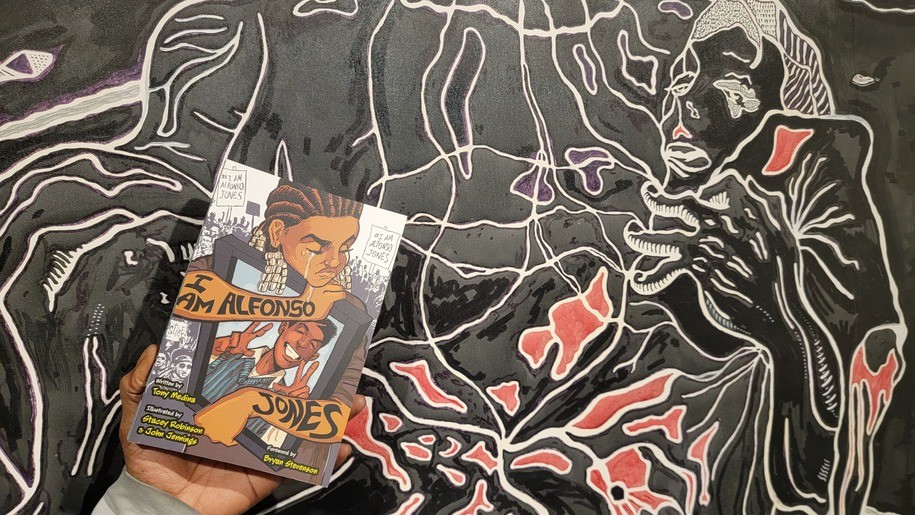
Why is a graphic novel for teens that Nikki Giovanni calls "incredibly enlightening” banned?
I Am Alfonso Jones by Tony Medina is a beautifully illustrated, moving story about an Afro Puerto Rican teen who gets killed by an off-duty police officer in Harlem. IAAJ is award winning graphic novel for young readers. It has won critical acclaim,...
m.dailykos.com
There's a lot of angles to this story. However, there's no where else to put a homeless shelter than a location that alleges it's a place for despair?I don't know how I feel about this one
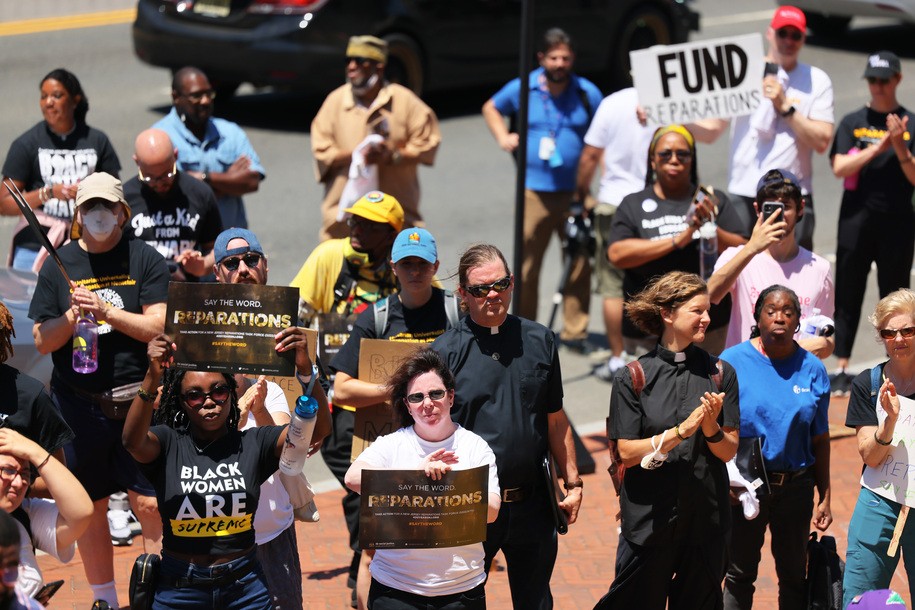
‘This is not charity’: A predominantly white congregation attempts reparations
Advocates debate the best way to scale and implement reparations to recognize centuries of slavery, segregation, and redlining that continue to impact Black Americans today. by Frances Nguyen ...
www.dailykos.com
I know her personally, I believe she will become Senator and much, much, more.
NY & Chicago but everyone needs to be aware.

 chicago.suntimes.com
chicago.suntimes.com
Police urge Jewish, other religious communities to be vigilant this weekend as neo-Nazi group declares ‘day of hate’
“At this time, there is no actionable intelligence,” according to the Chicago Police Department. “We continue to actively monitor the situation.”

America’s always had black inventors – even when the patent system explicitly excluded them
American slaves couldn’t hold property – including patents on their own inventions. But that didn’t stop black Americans from innovating since the beginning of the country’s history.
 getpocket.com
getpocket.com
America has long been the land of innovation. More than 13,000 years ago, the Clovis people created what many call the “ first American invention” – a stone tool used primarily to hunt large game. This spirit of American creativity has persisted through the millennia, through the first American patent granted in 1641 and on to today.
One group of prolific innovators, however, has been largely ignored by history: Black inventors born or forced into American slavery. Though U.S. patent law was created with color-blind language to foster innovation, the patent system consistently excluded these inventors from recognition.
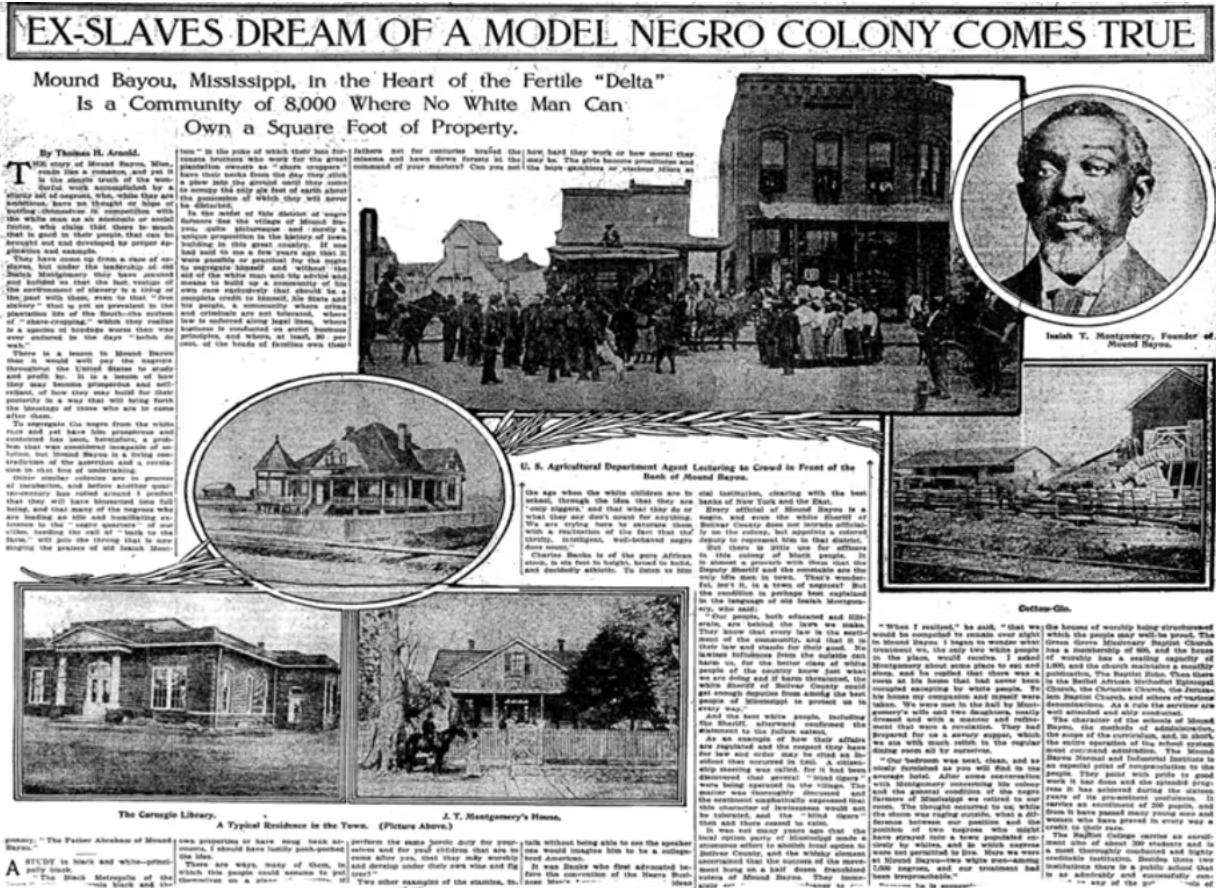
A New York Times article from 1910 describes founding of Mound Bayou, a town founded on the wealth of a steamboat patent. SundayMagazine.org
As a law professor and a licensed patent attorney, I understand both the importance of protecting inventions and the negative impact of being unable to use the law to do so. But despite patents being largely out of reach to them throughout early U.S. history, both slaves and free African-Americans did invent and innovate.
Why Patents Matter
In many countries around the world, innovation is fostered through a patent system. Patents give inventors a monopoly over their invention for a limited time period, allowing them, if they wish, to make money through things like sales and licensing.
The patent system has long been the heart of America’s innovation policy. As a way to recoup costs, patents provide strong incentives for inventors, who can spend millions of dollars and a significant amount of time developing a invention.
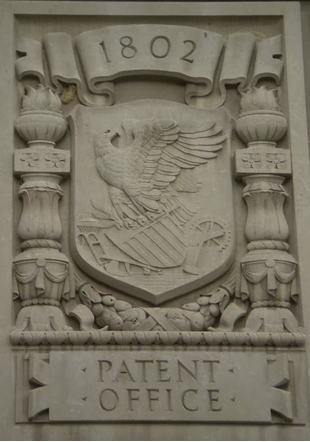
Patent Office relief on the Herbert C. Hoover Building. Neutrality
The history of patents in America is older than the U.S. Constitution, with several colonies granting patents years before the Constitution was created. In 1787, however, members of the Constitutional Convention opened the patent process up to people nationwide by drafting what has come to be known as the Patent and Copyright Clause of the Constitution. It allows Congress:
Though the language itself was race-neutral, like many of the rights set forth in the Constitution, the patent system didn’t apply for Black Americans born into slavery. Slaves were not considered American citizens and laws at the time prevented them from applying for or holding property, including patents. In 1857, the U.S. commissioner of patents officially ruled that slave inventions couldn’t be patented.
Slaves’ Inventions Exploited by Owners
During the 17th and 18th centuries, America was experiencing rapid economic growth. Black inventors were major contributors during this era – even though most did not obtain any of the benefits associated with their inventions since they could not receive patent protection.
Slave owners often took credit for their slaves’ inventions. In one well-documented case, a Black inventor named Ned invented an effective, innovative cotton scraper. His slave master, Oscar Stewart, attempted to patent the invention. Because Stewart was not the actual inventor, and because the actual inventor was born into slavery, the application was rejected.
Stewart ultimately began selling the cotton scraper without the benefit of patent protection and made a significant amount of money doing so. In his advertisements, he openly touted that the product was “the invention of a Negro slave – thus giving the lie to the abolition cry that slavery dwarfs the mind of the Negro. When did a free Negro ever invent anything?”
Reaping Benefits of Own Inventions
The answer to this question is that Black people – both free and enslaved – invented many things during that time period.
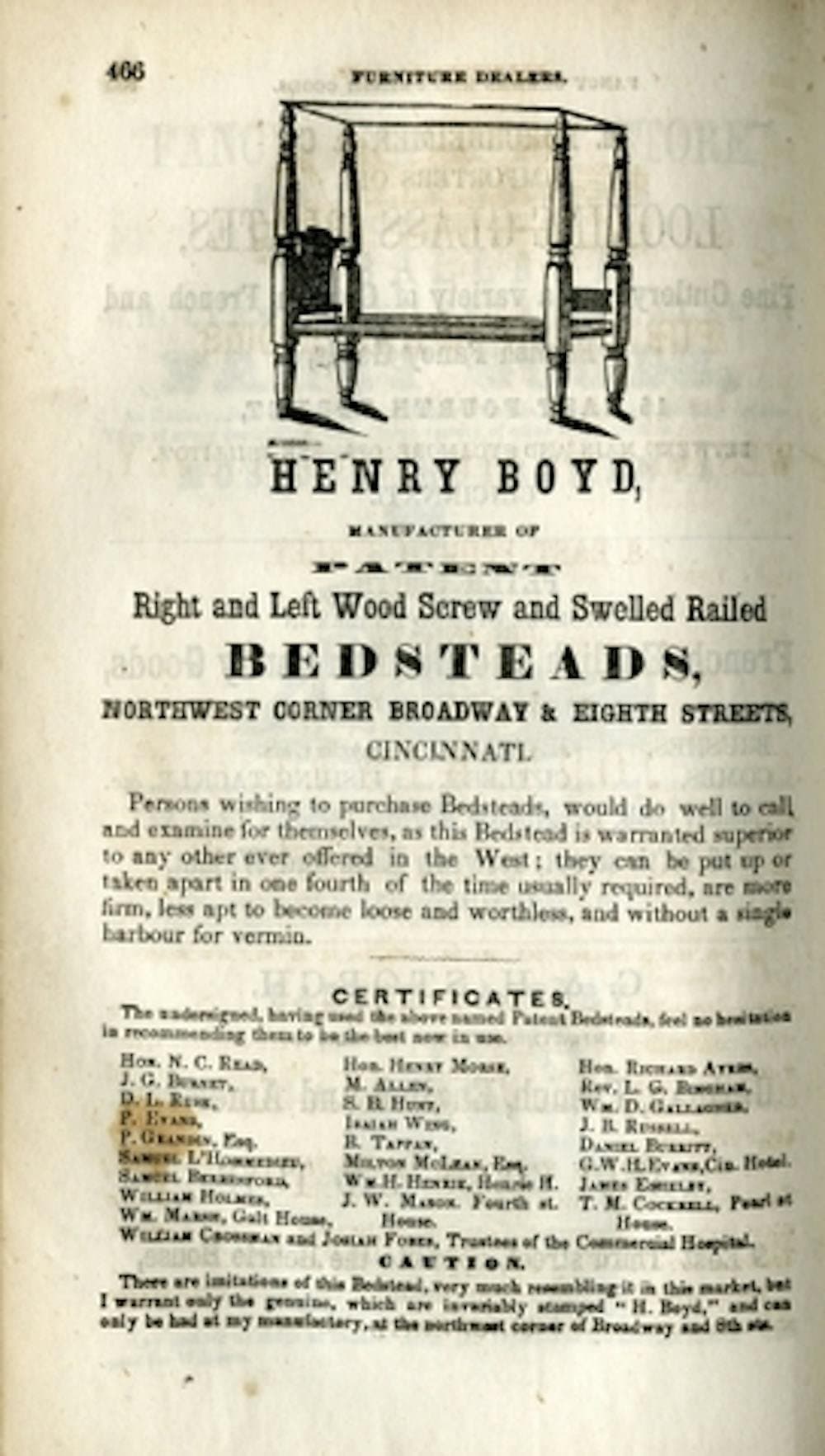
One such innovator was Henry Boyd, who was born into slavery in Kentucky in 1802. After purchasing his own freedom in 1826, Boyd invented a corded bed created with wooden rails connected to the headboard and footboard.
The “Boyd Bedstead” was so popular that historian Carter G. Woodson profiled his success in the iconic book “The Mis-education of the Negro,” noting that Boyd’s business ultimately employed 25 white and Black employees.
Though Boyd had recently purchased his freedom and should have been allowed a patent for his invention, the racist realities of the time apparently led him to believe that he wouldn’t be able to patent his invention. He ultimately decided to partner with a white craftsman, allowing his partner to apply for and receive a patent for the bed.
Some Black inventors achieved financial success but no patent protection, direct or indirect. Benjamin Montgomery, who was born into slavery in 1819, invented a steamboat propeller designed for shallow waters in the 1850s. This invention was of particular value because, during that time, steamboats delivered food and other necessities through often-shallow waterways connecting settlements. If the boats got stuck, life-sustaining supplies would be delayed for days or weeks.
Montgomery tried to apply for a patent. The application was rejected due to his status as a slave. Montgomery’s owners tried to take credit for the propeller invention and patent it themselves, but the patent office also rejected their application because they were not the true inventors.
Even without patent protection, Montgomery amassed significant wealth and become one of the wealthiest planters in Mississippi after the Civil War ended. Eventually his son, Isaiah, was able to purchase more than 800 acres of land and found the town of Mound Bayou, Mississippi after his father’s death.
A Legacy of Black Innovators
The patent system was ostensibly open to free Black people. From Thomas Jennings, the first Black patent holder, who invented dry cleaning in 1821, to Norbert Rillieux, a free man who invented a revolutionary sugar-refining process in the 1840s, to Elijah McCoy, who obtained 57 patents over his lifetime, those with access to the patent system invented items that still touch the lives of people today.
This legacy extends through the 21st century. Lonnie Johnson generated more than US$1 billion in sales with his Super Soaker water gun invention, which has consistently been among the world’s top 20 best-selling toys each year since 1991. Johnson now owns more than 80 patents and has since developed different green technologies.
Bishop Curry V, a 10-year-old Black inventor from Texas, has already applied for a patent for his invention, which he says will stop accidental deaths of children in hot cars.
Black women are also furthering the legacy of Black inventors. Lisa Ascolese, known as “The Inventress,” has received multiple patents and founded the Association for Women Inventors and Entrepreneurs. Janet Emerson Bashen became the first Black woman to receive a patent for a software invention in 2006. And Dr. Hadiyah Green recently won a $1 million grant related to an invention that may help treat cancer.
rue to the legacy of American innovation, today’s Black inventors are following in the footsteps of those who came before them. Now patent law doesn’t actively exclude them from protecting their inventions – and fully contributing to American progress.
Shontavia Johnson is the Associate Vice President for Academic Partnerships and Innovation at Clemson University.
One group of prolific innovators, however, has been largely ignored by history: Black inventors born or forced into American slavery. Though U.S. patent law was created with color-blind language to foster innovation, the patent system consistently excluded these inventors from recognition.

A New York Times article from 1910 describes founding of Mound Bayou, a town founded on the wealth of a steamboat patent. SundayMagazine.org
As a law professor and a licensed patent attorney, I understand both the importance of protecting inventions and the negative impact of being unable to use the law to do so. But despite patents being largely out of reach to them throughout early U.S. history, both slaves and free African-Americans did invent and innovate.
Why Patents Matter
In many countries around the world, innovation is fostered through a patent system. Patents give inventors a monopoly over their invention for a limited time period, allowing them, if they wish, to make money through things like sales and licensing.
The patent system has long been the heart of America’s innovation policy. As a way to recoup costs, patents provide strong incentives for inventors, who can spend millions of dollars and a significant amount of time developing a invention.

Patent Office relief on the Herbert C. Hoover Building. Neutrality
The history of patents in America is older than the U.S. Constitution, with several colonies granting patents years before the Constitution was created. In 1787, however, members of the Constitutional Convention opened the patent process up to people nationwide by drafting what has come to be known as the Patent and Copyright Clause of the Constitution. It allows Congress:
This language gives inventors exclusive rights to their inventions. It forms the foundation for today’s nationwide, federal patent system, which no longer allows states to grant patents.“To promote the Progress of Science and useful Arts, by securing for limited Times to Authors and Inventors the exclusive Right to their respective Writings and Discoveries.”
Though the language itself was race-neutral, like many of the rights set forth in the Constitution, the patent system didn’t apply for Black Americans born into slavery. Slaves were not considered American citizens and laws at the time prevented them from applying for or holding property, including patents. In 1857, the U.S. commissioner of patents officially ruled that slave inventions couldn’t be patented.
Slaves’ Inventions Exploited by Owners
During the 17th and 18th centuries, America was experiencing rapid economic growth. Black inventors were major contributors during this era – even though most did not obtain any of the benefits associated with their inventions since they could not receive patent protection.
Slave owners often took credit for their slaves’ inventions. In one well-documented case, a Black inventor named Ned invented an effective, innovative cotton scraper. His slave master, Oscar Stewart, attempted to patent the invention. Because Stewart was not the actual inventor, and because the actual inventor was born into slavery, the application was rejected.
Stewart ultimately began selling the cotton scraper without the benefit of patent protection and made a significant amount of money doing so. In his advertisements, he openly touted that the product was “the invention of a Negro slave – thus giving the lie to the abolition cry that slavery dwarfs the mind of the Negro. When did a free Negro ever invent anything?”
Reaping Benefits of Own Inventions
The answer to this question is that Black people – both free and enslaved – invented many things during that time period.

One such innovator was Henry Boyd, who was born into slavery in Kentucky in 1802. After purchasing his own freedom in 1826, Boyd invented a corded bed created with wooden rails connected to the headboard and footboard.
The “Boyd Bedstead” was so popular that historian Carter G. Woodson profiled his success in the iconic book “The Mis-education of the Negro,” noting that Boyd’s business ultimately employed 25 white and Black employees.
Though Boyd had recently purchased his freedom and should have been allowed a patent for his invention, the racist realities of the time apparently led him to believe that he wouldn’t be able to patent his invention. He ultimately decided to partner with a white craftsman, allowing his partner to apply for and receive a patent for the bed.
Some Black inventors achieved financial success but no patent protection, direct or indirect. Benjamin Montgomery, who was born into slavery in 1819, invented a steamboat propeller designed for shallow waters in the 1850s. This invention was of particular value because, during that time, steamboats delivered food and other necessities through often-shallow waterways connecting settlements. If the boats got stuck, life-sustaining supplies would be delayed for days or weeks.
Montgomery tried to apply for a patent. The application was rejected due to his status as a slave. Montgomery’s owners tried to take credit for the propeller invention and patent it themselves, but the patent office also rejected their application because they were not the true inventors.
Even without patent protection, Montgomery amassed significant wealth and become one of the wealthiest planters in Mississippi after the Civil War ended. Eventually his son, Isaiah, was able to purchase more than 800 acres of land and found the town of Mound Bayou, Mississippi after his father’s death.
A Legacy of Black Innovators
The patent system was ostensibly open to free Black people. From Thomas Jennings, the first Black patent holder, who invented dry cleaning in 1821, to Norbert Rillieux, a free man who invented a revolutionary sugar-refining process in the 1840s, to Elijah McCoy, who obtained 57 patents over his lifetime, those with access to the patent system invented items that still touch the lives of people today.
This legacy extends through the 21st century. Lonnie Johnson generated more than US$1 billion in sales with his Super Soaker water gun invention, which has consistently been among the world’s top 20 best-selling toys each year since 1991. Johnson now owns more than 80 patents and has since developed different green technologies.
Bishop Curry V, a 10-year-old Black inventor from Texas, has already applied for a patent for his invention, which he says will stop accidental deaths of children in hot cars.
Black women are also furthering the legacy of Black inventors. Lisa Ascolese, known as “The Inventress,” has received multiple patents and founded the Association for Women Inventors and Entrepreneurs. Janet Emerson Bashen became the first Black woman to receive a patent for a software invention in 2006. And Dr. Hadiyah Green recently won a $1 million grant related to an invention that may help treat cancer.
rue to the legacy of American innovation, today’s Black inventors are following in the footsteps of those who came before them. Now patent law doesn’t actively exclude them from protecting their inventions – and fully contributing to American progress.
Shontavia Johnson is the Associate Vice President for Academic Partnerships and Innovation at Clemson University.

America’s always had black inventors – even when the patent system explicitly excluded them
American slaves couldn’t hold property – including patents on their own inventions. But that didn’t stop black Americans from innovating since the beginning of the country’s history.getpocket.com
America has long been the land of innovation. More than 13,000 years ago, the Clovis people created what many call the “ first American invention” – a stone tool used primarily to hunt large game. This spirit of American creativity has persisted through the millennia, through the first American patent granted in 1641 and on to today.
One group of prolific innovators, however, has been largely ignored by history: Black inventors born or forced into American slavery. Though U.S. patent law was created with color-blind language to foster innovation, the patent system consistently excluded these inventors from recognition.

A New York Times article from 1910 describes founding of Mound Bayou, a town founded on the wealth of a steamboat patent. SundayMagazine.org
As a law professor and a licensed patent attorney, I understand both the importance of protecting inventions and the negative impact of being unable to use the law to do so. But despite patents being largely out of reach to them throughout early U.S. history, both slaves and free African-Americans did invent and innovate.
Why Patents Matter
In many countries around the world, innovation is fostered through a patent system. Patents give inventors a monopoly over their invention for a limited time period, allowing them, if they wish, to make money through things like sales and licensing.
The patent system has long been the heart of America’s innovation policy. As a way to recoup costs, patents provide strong incentives for inventors, who can spend millions of dollars and a significant amount of time developing a invention.

Patent Office relief on the Herbert C. Hoover Building. Neutrality
The history of patents in America is older than the U.S. Constitution, with several colonies granting patents years before the Constitution was created. In 1787, however, members of the Constitutional Convention opened the patent process up to people nationwide by drafting what has come to be known as the Patent and Copyright Clause of the Constitution. It allows Congress:
This language gives inventors exclusive rights to their inventions. It forms the foundation for today’s nationwide, federal patent system, which no longer allows states to grant patents.
Though the language itself was race-neutral, like many of the rights set forth in the Constitution, the patent system didn’t apply for Black Americans born into slavery. Slaves were not considered American citizens and laws at the time prevented them from applying for or holding property, including patents. In 1857, the U.S. commissioner of patents officially ruled that slave inventions couldn’t be patented.
Slaves’ Inventions Exploited by Owners
During the 17th and 18th centuries, America was experiencing rapid economic growth. Black inventors were major contributors during this era – even though most did not obtain any of the benefits associated with their inventions since they could not receive patent protection.
Slave owners often took credit for their slaves’ inventions. In one well-documented case, a Black inventor named Ned invented an effective, innovative cotton scraper. His slave master, Oscar Stewart, attempted to patent the invention. Because Stewart was not the actual inventor, and because the actual inventor was born into slavery, the application was rejected.
Stewart ultimately began selling the cotton scraper without the benefit of patent protection and made a significant amount of money doing so. In his advertisements, he openly touted that the product was “the invention of a Negro slave – thus giving the lie to the abolition cry that slavery dwarfs the mind of the Negro. When did a free Negro ever invent anything?”
Reaping Benefits of Own Inventions
The answer to this question is that Black people – both free and enslaved – invented many things during that time period.

One such innovator was Henry Boyd, who was born into slavery in Kentucky in 1802. After purchasing his own freedom in 1826, Boyd invented a corded bed created with wooden rails connected to the headboard and footboard.
The “Boyd Bedstead” was so popular that historian Carter G. Woodson profiled his success in the iconic book “The Mis-education of the Negro,” noting that Boyd’s business ultimately employed 25 white and Black employees.
Though Boyd had recently purchased his freedom and should have been allowed a patent for his invention, the racist realities of the time apparently led him to believe that he wouldn’t be able to patent his invention. He ultimately decided to partner with a white craftsman, allowing his partner to apply for and receive a patent for the bed.
Some Black inventors achieved financial success but no patent protection, direct or indirect. Benjamin Montgomery, who was born into slavery in 1819, invented a steamboat propeller designed for shallow waters in the 1850s. This invention was of particular value because, during that time, steamboats delivered food and other necessities through often-shallow waterways connecting settlements. If the boats got stuck, life-sustaining supplies would be delayed for days or weeks.
Montgomery tried to apply for a patent. The application was rejected due to his status as a slave. Montgomery’s owners tried to take credit for the propeller invention and patent it themselves, but the patent office also rejected their application because they were not the true inventors.
Even without patent protection, Montgomery amassed significant wealth and become one of the wealthiest planters in Mississippi after the Civil War ended. Eventually his son, Isaiah, was able to purchase more than 800 acres of land and found the town of Mound Bayou, Mississippi after his father’s death.
A Legacy of Black Innovators
The patent system was ostensibly open to free Black people. From Thomas Jennings, the first Black patent holder, who invented dry cleaning in 1821, to Norbert Rillieux, a free man who invented a revolutionary sugar-refining process in the 1840s, to Elijah McCoy, who obtained 57 patents over his lifetime, those with access to the patent system invented items that still touch the lives of people today.
This legacy extends through the 21st century. Lonnie Johnson generated more than US$1 billion in sales with his Super Soaker water gun invention, which has consistently been among the world’s top 20 best-selling toys each year since 1991. Johnson now owns more than 80 patents and has since developed different green technologies.
Bishop Curry V, a 10-year-old Black inventor from Texas, has already applied for a patent for his invention, which he says will stop accidental deaths of children in hot cars.
Black women are also furthering the legacy of Black inventors. Lisa Ascolese, known as “The Inventress,” has received multiple patents and founded the Association for Women Inventors and Entrepreneurs. Janet Emerson Bashen became the first Black woman to receive a patent for a software invention in 2006. And Dr. Hadiyah Green recently won a $1 million grant related to an invention that may help treat cancer.
rue to the legacy of American innovation, today’s Black inventors are following in the footsteps of those who came before them. Now patent law doesn’t actively exclude them from protecting their inventions – and fully contributing to American progress.
Shontavia Johnson is the Associate Vice President for Academic Partnerships and Innovation at Clemson University.
As far as inventions are concerned, I remember being "taught" that Thomas Jefferson was this prolific thinker. "The man of 1,000 patents."
Then you find out he had over 500 slaves "working" for him. Slaves couldn't be credited as inventors on patents, so then I thought to myself what would be more likely. 1 man coming up with over 1,000 unique and patentable ideas...... or 500 people that actually do things daily, with their hands and in most cases with limited tools, coming up with at least 2 patentable ideas?
Fuck Thomas Jefferson.....and the rose colored glasses mfkrs tend to view this country's history with.
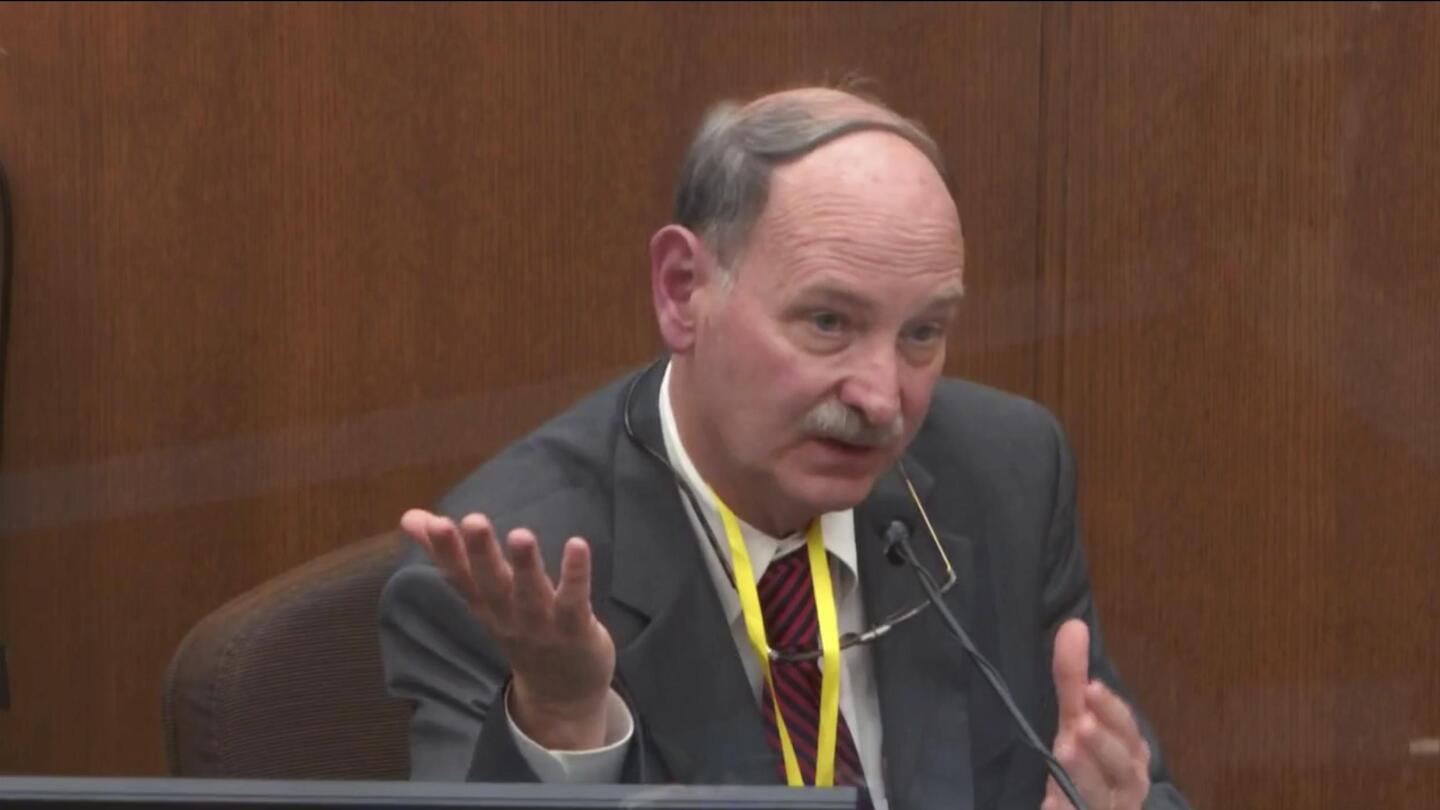
Medical examiners group steps away from 'excited delirium'
A leading group of medical experts says the term “excited delirium” should not be listed as a cause of death. Critics have said the term has been used to justify excessive force by police. The National Association of Medical Examiners had been one of the last to take a stand against the commonly...
Thread from 2021
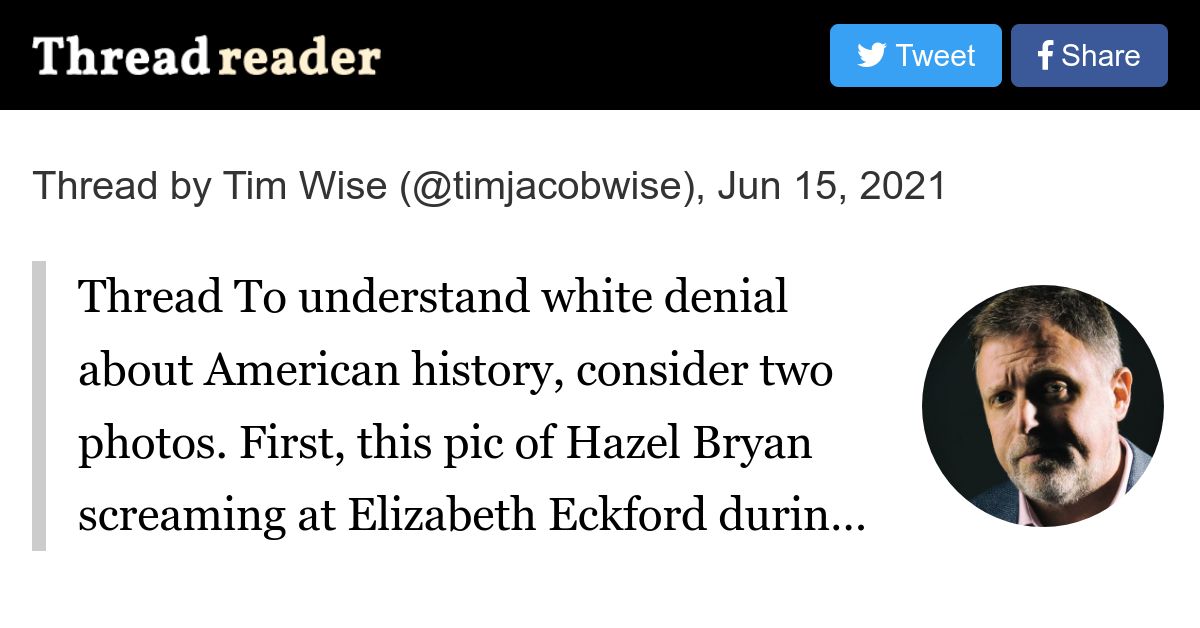
 threadreaderapp.com
threadreaderapp.com

Thread by @timjacobwise on Thread Reader App
@timjacobwise: Thread To understand white denial about American history, consider two photos. First, this pic of Hazel Bryan screaming at Elizabeth Eckford during the integration of Little Rock Central High. The dat...…
Thread
To understand white denial about American history, consider two photos. First, this pic of Hazel Bryan screaming at Elizabeth Eckford during the integration of Little Rock Central High. The date: September 4, 1957. As for the second photo, follow along...(1)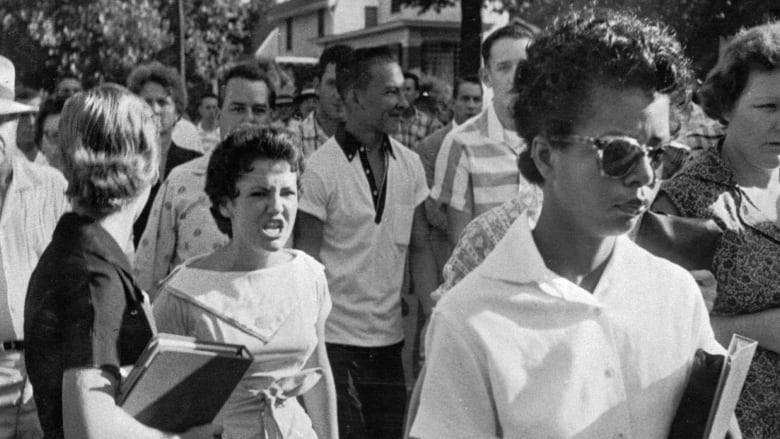
This is a promo pic for the TV show Leave it to Beaver: a much-beloved program, especially for white conservatives, who view it as a nostalgic representation of family life and the ultimate example of a more "innocent time..." But here's the thing...(2)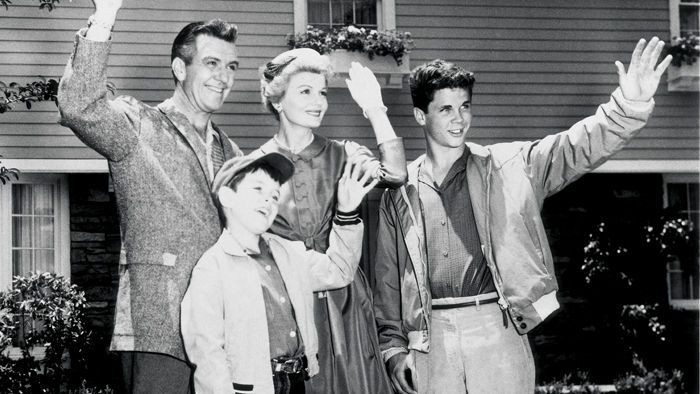
Leave it to Beaver premiered on October 4, 1957: one month to the day after that photo from Little Rock was taken. America was not innocent, and the evil wasn't only in the heart of Hazel Bryan or other Little Rock whites. It was a national sickness. One most whites ignored...(3)
...or simply couldn't allow themselves to see. Any nation that produces hagiographic representations of itself, at a time when others are being assailed and destroyed, deserves to be exposed as the fraud it is...(4)
And those who bought the lie -- whose childhoods were dependent upon it -- deserve to have their memories assaulted with truth, to be confronted with reality no matter how difficult. It's called growing up. It's called not being able to wallow in infantile naivete anymore...(5)
White Americans have an understanding of this country which is, by and large, infantile. And we are held hostage by our own ignorance. James Baldwin said it best...(6)
'These innocent people are trapped in a history they do not understand, and until they understand it, they cannot be released from it.' We want release without recognition, pardon without pain, forgiveness without facing the truth of what this nation has done in OUR name...(7)
And to our relative benefit for centuries. We want the America of the Cleaver family, because we fail to realize it NEVER EXISTED. It was a myth. A lie. Always. Reality was represented by that other picture from Little Rock...(8)
And it wasn't just the overt haters like Hazel Bryan and her fellow racist students. It was the millions of whites who maybe wouldn't have screamed hate like that, but did NOTHING to bring down segregation. That was the vast majority of our parents/grandparents...(9)
And that silence, that acquiescence, was more evil than Hazel Bryan. At least Hazel had the courage of her awful convictions. Far worse to be the white person who accepted segregation quietly and compromised their humanity without even having the guts to own their sickness...(10)
At some point, we will have to grow up, like it or not. This country cannot much longer abide white denial and the perpetuation of the mythology that passes for American history. That mythology tethers us to systems of injustice and prevents us from becoming what we could...(11)
And it guarantees conflict and violence in years to come. We must kill the mythology and bury the lies deep in the soil. Only this will save the country from utter ruin (END)
To understand white denial about American history, consider two photos. First, this pic of Hazel Bryan screaming at Elizabeth Eckford during the integration of Little Rock Central High. The date: September 4, 1957. As for the second photo, follow along...(1)

This is a promo pic for the TV show Leave it to Beaver: a much-beloved program, especially for white conservatives, who view it as a nostalgic representation of family life and the ultimate example of a more "innocent time..." But here's the thing...(2)

Leave it to Beaver premiered on October 4, 1957: one month to the day after that photo from Little Rock was taken. America was not innocent, and the evil wasn't only in the heart of Hazel Bryan or other Little Rock whites. It was a national sickness. One most whites ignored...(3)
...or simply couldn't allow themselves to see. Any nation that produces hagiographic representations of itself, at a time when others are being assailed and destroyed, deserves to be exposed as the fraud it is...(4)
And those who bought the lie -- whose childhoods were dependent upon it -- deserve to have their memories assaulted with truth, to be confronted with reality no matter how difficult. It's called growing up. It's called not being able to wallow in infantile naivete anymore...(5)
White Americans have an understanding of this country which is, by and large, infantile. And we are held hostage by our own ignorance. James Baldwin said it best...(6)
'These innocent people are trapped in a history they do not understand, and until they understand it, they cannot be released from it.' We want release without recognition, pardon without pain, forgiveness without facing the truth of what this nation has done in OUR name...(7)
And to our relative benefit for centuries. We want the America of the Cleaver family, because we fail to realize it NEVER EXISTED. It was a myth. A lie. Always. Reality was represented by that other picture from Little Rock...(8)
And it wasn't just the overt haters like Hazel Bryan and her fellow racist students. It was the millions of whites who maybe wouldn't have screamed hate like that, but did NOTHING to bring down segregation. That was the vast majority of our parents/grandparents...(9)
And that silence, that acquiescence, was more evil than Hazel Bryan. At least Hazel had the courage of her awful convictions. Far worse to be the white person who accepted segregation quietly and compromised their humanity without even having the guts to own their sickness...(10)
At some point, we will have to grow up, like it or not. This country cannot much longer abide white denial and the perpetuation of the mythology that passes for American history. That mythology tethers us to systems of injustice and prevents us from becoming what we could...(11)
And it guarantees conflict and violence in years to come. We must kill the mythology and bury the lies deep in the soil. Only this will save the country from utter ruin (END)
I'm going to start donating to this group soon

 www.propublica.org
www.propublica.org

Blocked Crossings Force Kids to Crawl Under Trains to Get to School
When crossings are blocked for hours, kids risk their lives to get to school by crawling through trains that could start at any moment. Ambulances and fire trucks can’t get through. The problem has existed for decades. But it’s getting worse.
I'm going to start donating to this group soon

Blocked Crossings Force Kids to Crawl Under Trains to Get to School
When crossings are blocked for hours, kids risk their lives to get to school by crawling through trains that could start at any moment. Ambulances and fire trucks can’t get through. The problem has existed for decades. But it’s getting worse.www.propublica.org
I didn't have to pass tracks to get to school but me and a friend were almost road kill one day. We were tired of waiting. I think we went under the train tho. As SOON as we were two seconds on the otherside that mofo moved. If we had delayed even 5 seconds more, I wouldn't be here to annoy the heck out of folks on BGOL.
Similar threads
- Replies
- 1
- Views
- 66
- Replies
- 3
- Views
- 150
- Replies
- 26K
- Views
- 174K



